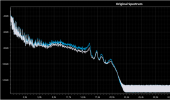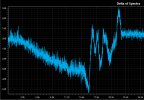widemediaphotography
Active Member
- Joined
- Jul 2, 2023
- Messages
- 178
- Likes
- 48
Hi,
As a dedicated measurer, I often clash with audiophiles who boast superpowers in listening, enabling them to appreciate the benefits of esoteric USB cables, CD transports, bit-perfect streamers, and so on.
Therefore, after upgrading my cartridge from AT-VM95E to AT-VM740ML, I devised a straightforward test, highly advantageous for those undergoing the test, sparing them the burden of memory. In fact, the file that you can download from the link:
Link to File:
https://we.tl/t-DrOfTbOiJN ( WISH YOU WERE HERE )
is composed by inserting at least one interval from the other.
By analyzing the measurements taken with DELTAWAVE,(see the images) it is evident that the two cartridges exhibit significantly different responses. For those who believe that listening takes precedence over measurements, recognizing the differences within the FLAC file should be straightforward.
The file has no interruptions and therefore allows continuous listening, avoiding stressing the memory to carry out the comparison
Feel free to share your results even via private message.
As a dedicated measurer, I often clash with audiophiles who boast superpowers in listening, enabling them to appreciate the benefits of esoteric USB cables, CD transports, bit-perfect streamers, and so on.
Therefore, after upgrading my cartridge from AT-VM95E to AT-VM740ML, I devised a straightforward test, highly advantageous for those undergoing the test, sparing them the burden of memory. In fact, the file that you can download from the link:
Link to File:
https://we.tl/t-DrOfTbOiJN ( WISH YOU WERE HERE )
is composed by inserting at least one interval from the other.
By analyzing the measurements taken with DELTAWAVE,(see the images) it is evident that the two cartridges exhibit significantly different responses. For those who believe that listening takes precedence over measurements, recognizing the differences within the FLAC file should be straightforward.
The file has no interruptions and therefore allows continuous listening, avoiding stressing the memory to carry out the comparison
Feel free to share your results even via private message.



